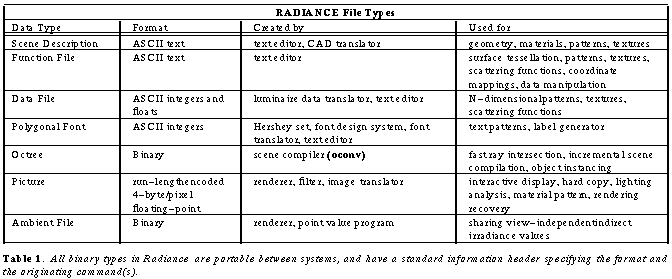
Radiance is a collection of C programs designed to work in concert, communicating via the standard data types listed in Table 1. The system may be compiled directly on most UNIX platforms, including SGI, Sun, HP, DEC, Apple (A/UX), and IBM (RS/6000). Portability is maintained over 60,000+ lines of code using the Kernighan and Ritchie standard [11] and conservative programming practices that do not rely on system-specific behaviors or libraries. (In addition to UNIX support, there is a fairly complete Amiga port by Per Bojsen, and a limited MS-DOS port by Karl Grau.)
A typical rendering session might begin with the user creating or modifying a geometric model of the space using a CAD program. (The user spends about 90% of the time on geometric modeling.) The CAD model is then translated into a Radiance scene description file, using either a stand-alone program or a function within the CAD system itself. The user might then create or modify the materials, patterns and textures associated with this model, and add some objects from a library of predefined light sources and furnishings. The completed model would then be compiled by oconv into an octree file, which would be passed to the interactive renderer, rview, to verify the desired view and calculation parameters. Finally, a batch rendering would be started with rpict, and after a few minutes or a few hours, the raw picture would be filtered (i.e. anti-aliased via image reduction) by pfilt using a suitable exposure level and target resolution. This finished picture may be displayed with ximage, translated to another format, printed, or further analyzed using one of the many Radiance image utilities. This illustrates the basic sequence of:
model -> convert -> render -> filter -> display
all of which may be put in a single pipelined command if desired.
As Radiance has evolved over the years, it has become increasingly sophisticated, with nearly 100 programs that do everything from CAD translation to surface tessellation to lighting calculations and rendering to image filtering, composition and conversion. With this sophistication comes great versatility, but learning the ins and outs of the programs, even the few needed for simple rendering, is impractical for most designers.
To overcome system complexity and improve the reliability of rendering results, we have written an executive control program, called rad. This program takes as its input a single file that identifies the material and scene description files needed as well as qualitative settings related to this environment and the simulation desired. The control program then calls the other programs with the proper parameters in the proper sequence.
The intricacies of the Radiance rendering pipeline are thus replaced by a few intuitive variable settings. For example, there is a variable called "DETAIL", which might be set to "low" for an empty room, "medium" for a room with a few pieces of furniture and "high" for a complicated room with many furnishings and textures. This variable will be used with a few others like it to determine how many rays to send out in the Monte Carlo sampling of indirect lighting, how closely to space these values, how densely to sample the image plane, and so on. One very important variable that affects nearly all rendering parameters is called "QUALITY". Low quality renderings come out quickly but may not look as good as medium quality renderings, and high quality renderings take a while but when they finish, the images can go straight into a magazine article.
This notion of replacing many algorithm-linked rendering parameters with a few qualitative variables has greatly improved the usability of Radiance and the reliability of its output. The control program also keeps track of octree creation, secondary source generation, aborted job recovery, image filtering and anti-aliasing, and running the interactive renderer. The encoding of expertise in this program has been so successful, in fact, that we rely on it ourselves almost 100% for setting parameters and controlling the rendering process.
Although the addition of a control program is a big improvement, there are still many aspects of Radiance that are not easily accessible to the average user. We have therefore added a number of utility scripts for performing specific tasks from the more general functions that constitute the system. One example of this is the falsecolor program, which calls other image filter programs and utilities to generate an image showing luminance contours or other data associated with a scene or rendering. Figure 9c shows our previous rendering (Figure 9a) superimposed with illuminance contours. These contours tell the lighting designer if there is enough light in the right places or too much light in the wrong places -- information that is difficult to determine from a normal image.
Even with a competent rendering control program and utility scripts for accomplishing specific tasks, there are still many designers who would not want to touch this system with an extended keyboard. Modern computer users expect a list of pull-down menus with point-and-click options that reduce the problem to a reasonably small and understandable set of alternatives. We are currently working on a graphical user interface (GUI) to the rad control program, which would at least put a friendlier face on the standard system. A more effective long-term solution is to customize the rendering interface for each problem domain, e.g. interior lighting design, daylighting, art, etc. Due to our limited resources and expertise, we have left this customization task to third parties who know more about specific applications, and who stand to benefit from putting their GUI on our simulation engine. So far, there are a half dozen or so developers working on interfaces to Radiance.